Jamaican cuisine includes a mixture of cooking techniques, flavours and spices influenced by Amerindian, West African, Irish, English, French, Portuguese, Spanish, Indian, Chinese and Middle Eastern people who have inhabited the island. It is also influenced by the crops introduced into the island from tropical Southeast Asia, many of which are now grown locally. A wide variety of seafood, tropical fruits and meats are available.
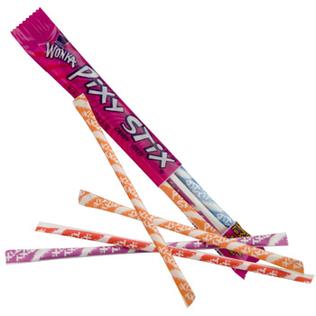
Pixy Stix are a sweet and sour colored powdered candy usually packaged in a wrapper that resembles a drinking straw.
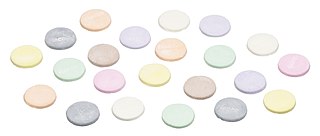
Necco Wafers are a sugar-based candy, sold in rolls of variously-flavored thin disks. First produced in 1847, they became the namesake and core product of the now-defunct New England Confectionery Company (Necco), which operated near Boston, Massachusetts. Production of the candy was suspended in July 2018 when Necco went into bankruptcy, but returned in May 2020 after purchase of the brand and production equipment by the Spangler Candy Company.
Sweet and sour is a generic term that encompasses many styles of sauce, cuisine, and cooking methods. It is commonly used in East Asia and Southeast Asia and has been used in England since the Middle Ages. Sweet and sour sauce remains popular in Asian and Western cuisines.

Nestlé Candy Shop was a confectionery brand owned and licensed by the Swiss corporation Nestlé. In 2018, the branding and production rights were sold to the Ferrero Group, and as a result, the brand was discontinued.
Tart 'n' Tinys are small, fruit-flavored candies distributed by Leaf Brands. Tart 'n' Tiny's were originally manufactured by the Wonka company in five colors, bluish-purple (grape), yellow (lemon), orange (orange), red (cherry), and green (lime). In 2015 when they were reintroduced, they added a new color, light blue.
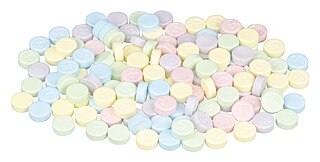
SweeTarts are sweet and sour candies invented under the direction of Menlo F. Smith, CEO of Sunline Inc., in 1962. The candy was created using the same small basic recipe as the already popular Pixy Stix and Lik-M-Aid products.

Sour Patch Kids are a brand of soft candy with a coating of invert sugar and sour sugar. The tartaric and citric acids provide the candy with a sharp burst of tartness, while the inverted sugar gives the soft gummy its sweet flavor. Sour Patch Kids Extreme, which contains lactic acid in addition to the tartaric and citric acids, is considered the sourest variation in the Sour Patch line of candies. The slogans "Sour Then Sweet" and "Sour. Sweet. Gone." refer to the candy's sour-to-sweet taste.

Caramel apples or toffee apples are whole apples covered in a layer of caramel. They are created by dipping or rolling apples-on-a-stick in hot caramel, sometimes then rolling them in nuts or other small savories or confections, and allowing them to cool. When these additional ingredients, such as nut toppings, are added, the caramel apple can be called a taffy apple.
Punky's was a candy sold by Nestlé in the late-1980s and early-1990s. They came in a variety of sweet and sour fruit flavors. Punky's were small, oval in shape, and had a somewhat rough texture, with some slightly larger sugar crystals embedded in the candies.

A lemon drop is a sugar coated, lemon-flavored candy that is typically colored yellow and often shaped like a lemon. They can be sweet or have a more sour flavor. Lemon drops are made by boiling sugar, water and cream of tartar until it reaches the hard crack stage. As the mixture cools, lemon flavor is added. The candy is then rolled into long ropes, cut into small pieces and rolled in sugar. Lemon drops originated in England, where confectioners learned that adding acid such as lemon juice to the boiled sugar mixture prevented sugar from crystallizing.

Warheads is a brand of sour or tart candy manufactured by Impact Confections, located in Janesville, Wisconsin. They are marketed as an 'extreme' candy with an intense sour flavor. They have proven to be very popular, especially with young children; in 1999, Warheads were referred to as a "$40 million brand" (USD).

Gummies, gummi candies, gummy candies, or jelly sweets are a broad category of gelatin-based chewable sweets. Gummy bears, Sour Patch Kids, and Jelly Babies are widely popular and are a well-known part of the sweets industry. Gummies are available in a wide variety of shapes, most commonly seen as colorful depictions of living things such as bears, babies, or worms. Various brands such as Bassett's, Haribo, Albanese, Betty Crocker, Hersheys, Disney and Kellogg's manufacture various forms of gummy snacks, often targeted at young children. The name "gummi" originated in Germany, with the term "jelly sweets" more common in the United Kingdom.
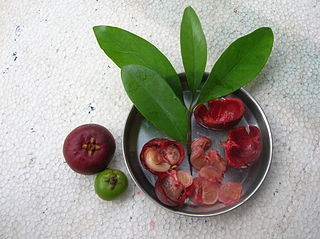
Garcinia indica, a plant in the mangosteen family (Clusiaceae), commonly known as kokum, is a fruit-bearing tree that has culinary, pharmaceutical, and industrial uses. It grows primarily in India's Western Ghats: in the states of Maharashtra, Goa, Karnataka and Kerala.
Wonka Gummies are a line of gummy sweets made by The Willy Wonka Candy Company. They were launched in 2009 and are available in 155.9g/5.5 ounce bags. The Sluggles, Puckerooms, Wingers, and Sploshberries were previously marketed as coming from Wonka's edible garden, up until November 2010.
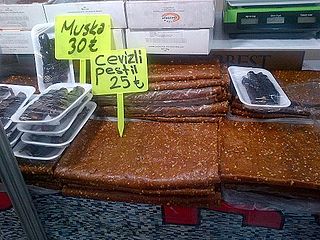
Pestil, also known as bastık or pastegh is dried fruit pulp, best exemplified in the English term "fruit leather." Fruit leather is made from mechanically pulverizing fruit, then spreading it out to dry into a tough, yet flexible and edible material which can be kept preserved for several months in an airtight container. It is a popular dessert in Armenia and Turkey.

Dried lime tea, also known as chai noomi basra, noomi basra tea or loomi tea, is a type of herbal tea made from dried limes that is traditional to the Arabian Peninsula.
Kiamoy, is a class of Filipino treats made with dried sour plums, prunes, or apricots preserved in brine and vinegar. They are sold covered in a powdery coating of an anise, li hing, salt, and sugar mixture called "kiamoy powder" or kiam-muy-hoon. They are characteristically bright red, orange, or light brown in color. They originate from Chinese Filipino immigrants and are derived from the li hing mui (旅行梅) treats of Chinese cuisine. The name is derived from Philippine Hokkien Chinese: 鹹梅; Pe̍h-ōe-jī: kiâm-muî; lit. 'salted plum'.












